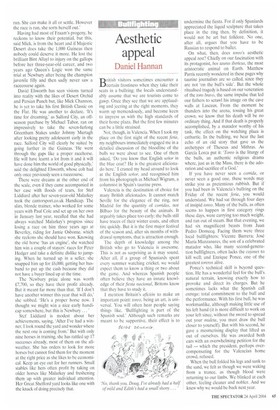Aesthetic appeal
Daniel Hannan
British visitors sometimes encounter a certain frostiness when they take their seats in a bullring; the locals understandably assume that we are tourists come to gawp. Once they see that we are applauding and jeering at the right moments, they warm up tremendously, and become keen to impress us with the high standards of their home plaza. But the first few minutes can be a little strained.
Not, though, in Valencia. When I took my place on the first night of the recent feria, my neighbours immediately engaged me in a detailed discussion of the bloodline of the bulls we were about to see. One of them asked, 'Do you know that English senor in the blue coat? He is the greatest aficionado here.' I craned my head around to look at the English senor, and recognised him from his photograph as Michael Wigram, a columnist in Spain's taurine press.
Valencia is the destination of choice for many British aficionados. It cannot match Seville for the elegance of the ring, nor Madrid for the quantity of conidas, nor Bilbao for the beauty of the animals. It arguably takes place too early: the bulls still have traces of their winter coats, and often tire quickly. But it is the first major festival of the season and, after six months of withdrawal symptoms, that is attraction enough.
The depth of knowledge among the British who go to Valencia is awesome. This is not as surprising as it may sound. After all, if a group of Spaniards spent every summer watching cricket, we would expect them to know a thing or two about the game. And whereas Spanish people often believe they have an innate knowledge of their fiesta nacional, Britons know that they have to study it.
I mention Britain's aficion to make an important point: tore°, being an art, is universal. You will often hear people saying things like, 'Bullfighting is part of the Spanish soul.' Although such remarks are meant to be supportive, their effect is to
undermine the fiesta. For if only Spaniards appreciated the liquid sculpture that takes place in the ring then, by definition, it would not be art but folklore. No one, after all, argues that you have to be Russian to respond to ballet.
On what, then, does toreo's aesthetic appeal rest? Chiefly on our fascination with its protagonist, bos tattrus ibericus, the most aristocratic animal on Earth. Matthew Parris recently wondered in these pages why taurine journalists are so called, since they are not 'on the bull's side'. But the whole ritualised tragedy is based on our veneration of the torn bravo, the same impulse that led our fathers to scrawl his image on the cave walls at Lascaux. From the moment he thunders into the arena, tossing his great crown, we know that his death will be no ordinary thing. And if that death is properly accomplished, by a matador worthy of his task, the effect on the watching plaza is cathartic. In the bullring, we hear the last echo of an old story that gave us the archetypes of Theseus and Mithras. As Garcia Lorca put it: 'Tore° is the liturgy of the bulls, an authentic religious drama where, just as in the Mass, there is the adoration and sacrifice of a God.'
If you have never seen a conida, or never seen a good one, these words may strike you as pretentious rubbish. But if you had been in Valencia's bullring on the Friday of the recent feria, you would understand. We had sat through four days of insipid tore°. Many of the bulls, as often seems to happen in first category rings these days, were carrying too much weight, and ran out of steam. But that evening, we had six magnificent beasts from Juan Pedro Domecq. Facing them were three local bullfighters: Vicente Barrera; Jose Maria Manzanares. the son of a celebrated matador who, like many second-generation bullfighters, often lacks the cojones to kill well; and Enrique Ponce, one of the greatest toreros alive.
Ponce's technical skill is beyond question. He has a wonderful feel for the bull's natural terrain, knowing exactly how to provoke and direct its charges. But he sometimes lacks what the Spanish call entrega: total commitment to the bull and the performance. With his first bull, he was workmanlike, although making little use of his left hand (it is more difficult to work on your left since, without the sword to spread out your muleta, you must draw the bull closer to yourself). But with his second, he gave a mesmerising display that lifted us out of ourselves. He was awarded both ears with an overwhelming petition for the tail — which the president. perhaps overcompensating for the Valencian home crowd, refused,
When the bull folded his legs and sank to the sand, we felt as though we were waking from a trance, as though blood were returning to our limbs. We blinked at each other, feeling cleaner and nobler. And we knew why we would be back next year.


















































































 Previous page
Previous page